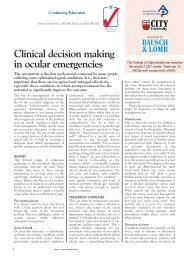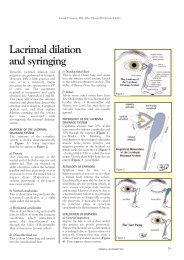Intraocular lens implantation - Optometry Today
Intraocular lens implantation - Optometry Today
Intraocular lens implantation - Optometry Today
Create successful ePaper yourself
Turn your PDF publications into a flip-book with our unique Google optimized e-Paper software.
Sponsored by<br />
Module 3 Part 11<br />
tissues in their physical properties and the<br />
smooth, hydrophilic nature minimises<br />
mechanical friction with ocular tissues and<br />
contributes to superior biocompatibility 10 . This<br />
is reported to produce less damage to the<br />
corneal endothelium after inadvertent touch<br />
on <strong>implantation</strong> than PMMA 11 . The hydrophilic<br />
nature of the <strong>lens</strong> surface causes low<br />
interfacial tension (wettability) of the<br />
hydrogel in aqueous solution and reduces the<br />
tendency of proteins to denature on the<br />
surface of the polymer, thus reducing<br />
biological rejection mechanisms. This possibly<br />
also prevents adhesion between the <strong>lens</strong> and<br />
the capsular bag. As the dimension of the<br />
hydrogel changes in direct proportion to the<br />
degree of water saturation, it enables<br />
<strong>implantation</strong> of a semi-hydrated <strong>lens</strong> through<br />
a small incision, for it to later expand in the<br />
eye as it becomes fully hydrated.<br />
Hydrophilic acrylics have the advantage of<br />
undergoing less damage during YAG laser<br />
capsulotomy. When there is direct impact of<br />
the YAG laser beam on the <strong>lens</strong>, mild to<br />
moderate localised pitting occurs, without the<br />
radial fracturing seen on a PMMA implant. This<br />
is due to the resilience of the material and its<br />
ability to act as a shock absorber rather than<br />
cracking under stress.<br />
Although high water-content polymers are<br />
usually mechanically weak, the hydrogels can<br />
be very strong owing to certain changes of the<br />
polymer produced during the process of<br />
polymerisation. Examples of hydrophilic<br />
acrylic IOLs are the Hydroview <strong>lens</strong>, EasAcryl,<br />
Inject-A, Centerflex and the Memory Lens.<br />
Studies on the Hydroview IOL (Bausch & Lomb)<br />
have shown that it is associated with fewer<br />
surface inflammatory cells than PMMA and a<br />
second-generation silicone IOL. However, a<br />
significant <strong>lens</strong> epithelial cell (LECs) reaction<br />
on the anterior IOL surface was reported in<br />
addition to a higher incidence of PCO 12,13 .<br />
AcrySof (Alcon) is an example of a<br />
hydrophobic acrylic IOL, which has become the<br />
most commonly inserted IOL in the USA. The<br />
AcrySof polymer was developed from the same<br />
backbone used in PMMA. It has a higher<br />
refractive index (1.55) than PMMA or silicone.<br />
This means that <strong>lens</strong> implants made from<br />
AcrySof are thinner, thereby facilitating<br />
folding and insertion through a smaller<br />
incision 14 .<br />
Acrylic polymers change their mechanical<br />
properties with temperature, being hard and<br />
glassy at low temperature, and soft and fluid<br />
at high temperature. This means that an IOL<br />
inserted at room temperature unfolds slowly<br />
and in a controlled manner 14 . This avoids the<br />
rapid, explosive opening which can be seen<br />
with three-piece silicone IOLs which may cause<br />
iatrogenic damage to the capsule or other<br />
anterior segment structures. The AcrySof IOL<br />
is, however, found by many surgeons to be<br />
more difficult to fold than silicone <strong>lens</strong>es, as<br />
the <strong>lens</strong> is more rigid if cool.<br />
In addition, due to its tacky nature, the<br />
AcrySof IOL has a tendency to stick to forceps<br />
or between two parts of the IOL on insertion 15 .<br />
This characteristic may mean that the IOL<br />
sticks to the capsular bag (which is discussed<br />
later and may have advantages), however, the<br />
adhesion means that the IOLs are more<br />
difficult to explant in cases of anisometropia<br />
or incorrect power calculation 16 . The IOLs are<br />
not slippery when wet in contrast to silicone<br />
IOLs.<br />
The AcrySof IOL has been found to be<br />
associated with dramatically reduced rates of<br />
PCO 17 . This is thought to be due to both<br />
mechanical and material features. This was the<br />
first <strong>lens</strong> implant to be manufactured with a<br />
square optic edge, and it is thought that this<br />
edge acts as a barrier to the migration of LECs<br />
onto the posterior capsule, reducing PCO. The<br />
tacky nature of the implant leads to increased<br />
adhesion of the IOL to the capsule which also<br />
probably limits the migration of LECs onto the<br />
posterior capsule.<br />
An IOL may have excellent cytological<br />
biocompatibility (a limited/nil inflammatory<br />
reaction), but poor capsular biocompatibility<br />
(the effect on anterior capsule and PCO), for<br />
example, the Hydroview IOL. Therefore, the<br />
goal is to find an IOL which has both<br />
cytological and capsular biocompatibility.<br />
Design features, such as a sharp optic edge,<br />
and material composition appear to be equally<br />
important. To date, the second-generation<br />
silicone IOLs and AcrySof IOLs appear to have<br />
the best biocompatibility.<br />
Table 4<br />
Advantages and disadvantages of the IOL types<br />
IOL Type Advantages Disadvantages<br />
PMMA Long term experience Rigid so need large incision<br />
Good biocompatibility<br />
Pits with YAG laser<br />
Cheap<br />
High incidence of PCO<br />
The prevalence of <strong>lens</strong> materials in the<br />
1997 survey of the American Society of<br />
Cataract and Refractive Surgery was 38%<br />
acrylic, 20% silicone, and 40% PMMA (Kohnen,<br />
1998). The <strong>implantation</strong> of foldable IOLs in<br />
Australia rose from 1% in 1991 to 67% in<br />
1997 18 .<br />
Multifocal IOLs<br />
Standard IOLs are monofocal and so the loss of<br />
accommodation which increases with age<br />
becomes absolute with surgery, and the need<br />
to correct the resultant presbyopia is apparent.<br />
Multifocal and bifocal IOLs have been designed<br />
in an attempt to provide both distance and<br />
near vision without additional spectacle<br />
correction, as they form separate images of<br />
near and distance objects. The goal of<br />
multifocal implants has been to enable<br />
patients to be less dependent on spectacles<br />
following surgery. Multifocal IOLs are based on<br />
the simultaneous vision principle – if the<br />
power difference between two optical systems<br />
is 3.00DS or more, then the images are<br />
dissimilar enough for the brain to interpret<br />
them as separate.<br />
An example is the ARRAY multifocal IOL by<br />
Allergan which has concentric rings of varying<br />
optical power around a central power for<br />
distance. The rings of power are for near<br />
distances, while the central distance power is<br />
dominant. Fifty per cent of the <strong>lens</strong> is<br />
dedicated to distance vision, 36% to near<br />
Silicone Foldable - small incision Low refractive index - thicker IOLs (first generation silicone)<br />
Fairly low incidence of PCO High refractive index - thinner IOLs (second generation silicone)<br />
(particularly second<br />
Pits with YAG laser<br />
generation silicone)<br />
Rapid unfolding in the eye<br />
Dislocation after YAG<br />
More decentration<br />
More anterior capsule contraction<br />
Slippery when wet<br />
Cannot use with silicone oil<br />
AcrySoft Foldable - small incision Short experience<br />
High refractive index - thin IOLs Tacky surface - sticks to forceps<br />
Very low incidence of PCO More difficult to fold<br />
LEC regression<br />
?Glistenings<br />
Biocompatible<br />
?Glare<br />
Fewer pits with YAG laser<br />
Slow uncontrolled folding<br />
Hydroview Foldable - small incision LECs on anterior IOL surface<br />
Good biocompatibility<br />
High incidence of PCO<br />
- low inflammatory cell reaction<br />
Fewer pits with YAG laser<br />
Controlled unfolding<br />
Less endothelial cell damage<br />
with cornea touch<br />
www.optometry.co.uk<br />
31
















